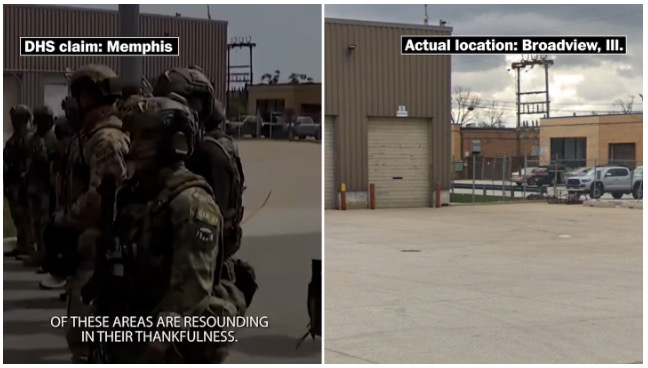Trump White House Defends Misleading DHS Propaganda Because They Are ‘Banger Memes’

Screenshot
The Department of Homeland Security has repeatedly posted misleading, mislabeled, and in at least one case digitally altered footage to promote President Donald Trump’s immigration agenda — an aggressive messaging strategy defended by the White House as engaging “banger memes,” according to a detailed Washington Post investigation published this week.
The Post identified at least six DHS-produced videos over the last three months that misrepresented where and when scenes were filmed. The most striking example was an August montage touting DHS’s supposed success in securing Washington, D.C. It featured dramatic clips of federal agents battling what one official called a “battle for the soul of our nation,” but the footage was neither recent nor from the nation’s capital. Instead, significant portions were shot months earlier in Los Angeles, West Palm Beach, and even off the coast of Nantucket, roughly 400 miles from Washington.
A DHS spokesperson did not dispute the inaccuracies. The White House also declined to offer corrections; instead, spokesperson Abigail Jackson said the administration would continue highlighting its successes via “engaging content and banger memes,” the Post reported.
The investigation found a broader pattern of deceptive editing. In one case, footage promoted as showing “Antifa terrorists” attacking federal facilities in Portland was actually filmed outside an ICE building in Broadview, Illinois — 1,700 miles away. The video also cropped out the watermark of the journalist who recorded it. Another DHS clip boasting about a federal surge into Memphis used images from the same Illinois facility, with no indication that the visuals were recorded in a different state.
In several instances, DHS also misrepresented the depicted time period. A video promoting Trump’s border policies showed nighttime crossings in Arizona and a smuggling boat at sea, claiming both scenes underscored the failures of earlier administrations. But the Post determined both events occurred in 2019 — during Trump’s own first term.
Even when real footage was used, DHS at times manipulated it. The Post reported that ICE shared an image of a woman holding a pro-ICE sign outside its Portland office. Critics suspected AI fabrication, but DHS provided surveillance video confirming the woman existed. Still, analysts found the image had been altered to digitally remove most of a Spanish-language curse — “Chinga la migra” — written on the pavement beneath her feet.
Secretary Kristi Noem, who heads DHS, has also come under scrutiny for her highly visible, television-friendly media operations that critics say are aimed more at shaping a narrative than conveying tough policy realities. Her public appearances — often staged with full makeup, law enforcement gear, and cameras rolling — have been described as photo-ops built for social platforms rather than plain reporting of results. Criticism has intensified over her use of agency resources and flashy visuals, especially as DHS expands its own video production arm and social media reach.
Experts quoted by the Post warned that the administration’s editing tactics risk undermining public trust, particularly during national emergencies when government accuracy is crucial. Former DHS official John Cohen cautioned that misleading content could cause people “to start tuning them out” when factual information is needed to de-escalate crises. Eddie Perez, a former Twitter civic integrity leader, said the administration was behaving like “filmmakers” focused on emotional manipulation rather than truth, calling the trend “the collapse of government accountability through communication based on facts.”
Despite criticism, DHS has expanded its in-house media operation — hiring videographers, deploying drones, and producing news-style segments that blast “fake news hoaxes” and direct viewers to government channels for the “FACTS.”
The extensive report, co-authored by Drew Harwell and Joyce Soyhun Lee, features numerous examples of original source material and the end-product video put forth by the DHS on social media. You can see those videos at The Washington Post (paywalled.)




